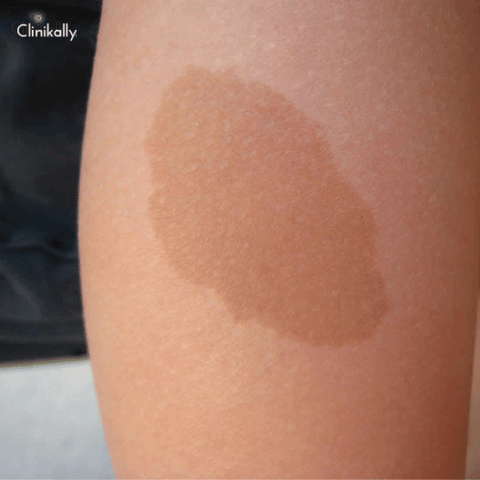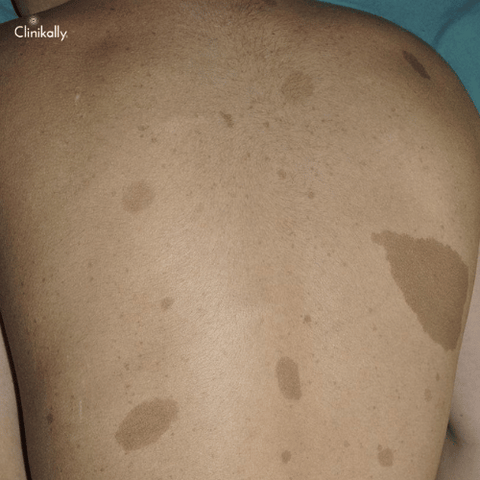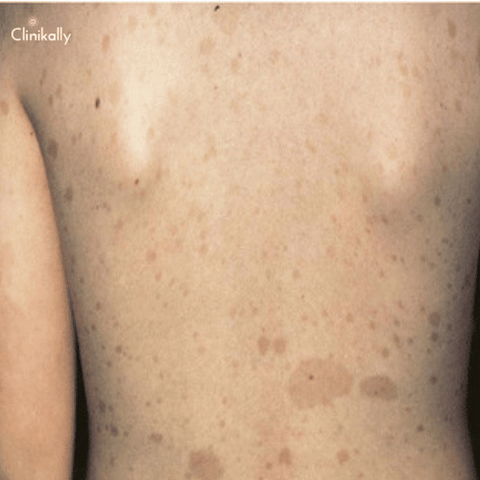Cafe-au-lait spots are brown birthmarks that are flat and equally coloured. They are normally oval or circular, and their colour ranges from light brown to dark brown. The spots were named after the French phrase "coffee with milk" since their colour is comparable to that of the famous beverage. An increase in melanin production in the afflicted area causes cafe-au-lait spots. Melanin is the pigment responsible for skin colour, and an increase in production can result in darker regions of the skin. While cafe-au-lait stands are normally harmless, they can occasionally indicate an underlying medical concern. In some situations, they may be a symptom of a hereditary condition such as neurofibromatosis type 1 or McCune-Albright syndrome. If cafe-au-lait spots appear suddenly, are very large, or are coupled with other symptoms like itchiness, pain, or texture changes, seek immediate medical attention.
What Are Cafe-au-Lait Spots?

Cafe-au-lait spots are flat, pigmented birthmarks or skin patches that are often oval-shaped and light brown in colour, simulating the colour of coffee with milk. These patches can occur anywhere on the body and range in diameter from a few millimetres to several centimetres. Cafe-au-lait stands are normally safe and do not create any medical issues. However, if a person has several cafe-au-lait spots or other symptoms like freckling in strange places, it could be a sign of an underlying medical disease.
Birthmarks and Hyperpigmentation
Café-au-lait spots are a type of birthmark that appears flat and smooth due to areas of enhanced pigmentation on the skin. They are usually oval or round in shape and light brown to dark brown in colour, similar to coffee with milk. The patches can range in diameter from a few millimetres to several centimetres and can appear anywhere on the body. Café-au-lait spots might be present at birth or occur during childhood, becoming more noticeable with age. They are a kind of hyperpigmentation that is normally harmless but, in some situations, might be a symptom of an underlying medical issue.
Melanin and Skin Discoloration
Melanin is a pigment that gives skin, hair, and eyes colour. It is produced by melanocytes and is essential for protecting the skin from the sun's ultraviolet (UV) rays. Melanin also controls the colour of our skin, hair, and eyes, and the amount of melanin in our skin varies based on genetic variables and sun exposure. Hyperpigmentation, particularly cafe-au-lait spots, occurs when melanin is overproduced in certain areas of the skin.
Cafe-au-Lait Spots and Associated Conditions

Cafe-au-lait establishments are generally safe and do not cause any symptoms or health issues. They can, however, be a sign of certain genetic conditions that affect skin pigmentation. These are some of the conditions:
-
Neurofibromatosis type 1 (NF1) is a genetic disorder that affects the nervous system and results in nerve tumours. Cafe-au-lait spots are a common NF1 symptom that can appear at birth or develop later in life. Other NF1 symptoms include learning disabilities, vision problems, and bone deformities.
-
McCune-Albright syndrome (MAS) is a rare genetic disorder that causes abnormal bone growth and hormonal imbalances. Cafe-au-lait spots, as well as other skin and bone abnormalities, are common symptoms of MAS. People with MAS may also have early puberty, thyroid problems, and other hormonal issues.
-
Legius syndrome is a rare genetic disorder that is similar to NF1 but has milder symptoms. Cafe-au-lait spots, as well as other skin and developmental abnormalities, are common symptoms of Legius syndrome. People with Legius syndrome may also have learning disabilities and speech delays.
It should be noted that having cafe-au-lait spots does not necessarily imply that a person has one of these illnesses. If there are several spots or other symptoms or health problems, a doctor may propose genetic testing or further assessment to rule out these illnesses.
Neurofibromatosis and McCune-Albright Syndrome
The occurrence of several cafe-au-lait spots is related to neurofibromatosis and McCune-Albright syndrome. Neurofibromatosis is a hereditary condition that affects the nervous system and can lead to the formation of tumours on nerve tissue. Cafe-au-lait spots are a common symptom of this disease, and people with neurofibromatosis may have multiple of them. Another hereditary condition that affects the bones and endocrine system is McCune-Albright Syndrome. The appearance of cafe-au-lait spots, as well as other symptoms such as early puberty, bone fractures, and hormonal imbalances, distinguishes it.
Legius Syndrome and Other Genetic Conditions
Legius syndrome is a rare genetic disorder that can result in cafe-au-lait spots. It is caused by SPRED1 gene mutations and is distinguished by numerous cafe-au-lait spots, freckling in the underarms and groyne area, and neurofibromas. Bloom syndrome, Fanconi anaemia, and Ataxia-telangiectasia are all hereditary diseases that can cause cafe-au-lait spots. Cafe-au-lait spots can be a sign of certain cancers, such as leukaemia or lymphoma, in some cases. It is crucial to note that having cafe-au-lait spots does not necessarily indicate that a person has an associated condition, but it is critical to consult with a healthcare professional for further assessment and diagnosis.
Diagnosis and Treatment Options

A dermatologist's physical examination is frequently required to diagnose cafe-au-lait spots. Genetic testing and examination may be required to rule out underlying disorders if the spots are frequent, greater than 0.5 cm in diameter, or linked with other symptoms. Cafe-au-lait spots are normally not treated unless they cause cosmetic problems or are related to an underlying ailment that necessitates treatment. If therapy is desired, the following options may be considered:
-
Laser therapy: Laser therapy can be used to reduce the size and colour of cafe-au-lait spots.
-
Chemical peels: Chemical peels can be used to reduce the appearance of cafe-au-lait spots, but they can also cause redness, swelling, and scarring.
-
Cryotherapy: In order to kill the cells that produce pigment, cryotherapy involves freezing the spots with liquid nitrogen. This treatment may result in scarring or changes in skin colour.
-
Surgery: Surgical removal of the spots may be an option in rare cases.
It should be noted that these treatments may not be helpful for all people and may result in adverse effects or consequences. As a result, it is critical to consult with a dermatologist or other medical practitioner before beginning.
Dermatological Evaluation
If you have a cafe-au-lait spot or many spots, it is critical to arrange an evaluation with a dermatologist. The dermatologist will inspect the spots to assess their characteristics and rule out any underlying medical concerns during the evaluation. To analyse the spots and look for any abnormalities, the dermatologist may use a dermatoscopy, a handheld device that provides a magnified examination of the skin. If the dermatologist detects an underlying medical disease, additional testing, such as genetic testing, may be ordered to confirm the diagnosis. The cause of the cafe-au-lait spots will determine the treatment options.
Laser treatments, topical lotions, and other cosmetic procedures to lighten or eradicate the spots may be used in cases when the spots are merely cosmetic and do not reflect an underlying medical issue. It is crucial to note that these treatments may not entirely remove the spots and that numerous sessions may be required for optimal outcomes. Before undertaking any treatment, it is also critical to discuss the potential dangers and side effects with a dermatologist.
Laser Therapy and Cosmetic Camouflage
Laser therapy and cosmetic camouflage are two possible treatments for cafe-au-lait spots.
-
Laser therapy: Targeting the melanin in the cafe-au-lait spot with a particular wavelength of light during laser therapy will cause it to disintegrate and be absorbed by the body. This treatment can lessen or remove cafe-au-lait spots, but many sessions may be required for the best results.
-
Cosmetic camouflage: Cosmetic camouflage is the use of makeup or other products to conceal the cafe-au-lait spot. This can be a good option for people who are not interested in or candidates for laser therapy.
It's important to remember that neither laser therapy nor cosmetic camouflage can heal the underlying illness that causes the cafe-au-lait spot, and they're not always completely effective at getting rid of it. It is critical to speak with a dermatologist about these options in order to determine the best course of action for each individual case.
When to Consult a Medical Professional
If you or a loved one detects an increase in the number or size of cafe-au-lait spots or if you have concerns about linked symptoms or disorders, you should see a doctor. A dermatologist or genetic counsellor can examine the spots and determine whether more testing or treatment is required. Furthermore, if you have a known hereditary issue linked to cafe-au-lait spots, you should consult with a healthcare team that can monitor and manage any associated health concerns.
Abnormal Skin Changes or Multiple Spots
If you see any abnormal skin changes or several café-au-lait spots, you should see a doctor for an additional assessment. Café-au-lait spots may be an indication of an underlying illness or syndrome, such as neurofibromatosis, in some situations. A medical practitioner can make an accurate diagnosis and, if necessary, offer appropriate treatment alternatives. It is also critical to examine any existing café-au-lait spots on a regular basis for changes in size, colour, or shape and to report any changes to a medical practitioner.
Seeking Proper Diagnosis and Treatment
If you see any abnormal skin changes or several cafe-au-lait spots, you should see a doctor for the correct diagnosis and treatment. A dermatologist or a geneticist can examine the patches to see if there are any underlying issues. They may recommend genetic or imaging tests to better assess the problem. If a genetic problem is discovered, the nature of the condition and the severity of the symptoms will dictate treatment. In some cases, no treatment is required; however, the condition should be monitored, and regular follow-up visits with a medical practitioner are recommended. Under the supervision of a dermatologist or cosmetic specialist, laser therapy or cosmetic camouflage can be considered for cosmetic concerns. It's also important to regularly inspect cafe-au-lait locations for changes in appearance. Consult a doctor as soon as possible if you observe any modifications in size, shape, or colour or if you experience any accompanying symptoms, such as itchiness, bleeding, or pain.
Living with Cafe-au-Lait Spots
Living with cafe-au-lait spots can be difficult, especially if they are visible and make you feel self-conscious. Here are some pointers to get you started:
-
Self-care: Taking good care of yourself is crucial if you want to feel secure and at ease in your own skin. This entails maintaining a balanced diet, exercising frequently, and getting enough rest.
-
Sun protection: Keeping your skin out of the sun can help stop further changes in pigmentation. Put on safety gear and broad-spectrum sunscreen with a minimum SPF of 30.
-
Support: To help you deal with any emotional stress or anxiety related to your appearance, you might think about finding support from a therapist or support group.
-
Communication: Discuss any worries or inquiries you may have about cafe-au-lait spots with your doctor. It is essential to make a precise diagnosis in order to rule out any underlying conditions.
-
Acceptance: Finding ways to accept and embrace your individual appearance can be a journey, but doing so can be empowering. It can help you discover your own special beauty.
Skin Care and Protection
You can protect your skin and lessen the appearance of spots even though there is no known treatment for cafe-au-lait spots. Here are some ideas for protecting and caring for your skin:
-
Sun protection: Even on cloudy days, use sunscreen with a high SPF whenever you are outside. To protect your face from sun damage, cover it with protective clothing and a wide-brimmed hat.
-
Avoid using harsh skin care products: Using harsh skin care products that irritate or dry out your skin can accentuate blemishes.
-
Apply moisturiser: Keeping your skin hydrated can help it look better overall and make spots less noticeable. Select a moisturiser that is gentle, fragrance-free and suitable for your skin type.
-
Regular check-ups: If you have cafe-au-lait spots, you should see a dermatologist on a regular basis to monitor any changes in the spots or surrounding skin.
-
Cosmetic camouflage: If you're self-conscious about the appearance of your cafe-au-lait spots, you can use cosmetic camouflage products to conceal them. These products are intended to conceal skin imperfections and come in a variety of shades to match your skin tone.
While cafe-au-lait spots can be unsightly, they are normally harmless and do not require treatment unless they are related to a medical issue. Consult your dermatologist or healthcare practitioner if you are concerned about your cafe-au-lait spots.
Coping with Cosmetic Concerns
Cafe-au-Lait stains are generally not dangerous and do not require treatment. Some people, however, may be self-conscious about their appearance and choose to explore cosmetic treatments. Here are some tips for dealing with cosmetic issues associated with Cafe-au-Lait spots:
-
Camouflage makeup: Using special makeup products like colour-correcting creams or concealers can help even out skin tone and conceal spots. These items can be found in most drugstores and beauty supply stores.
-
Self-tanning products: Using self-tanning products, such as sprays or lotions, can help darken the skin and hide the spots.
-
Clothing options: Wearing clothing that covers the affected areas, such as long sleeves or pants, can help conceal the spots.
-
Positive self-talk: Although it is natural to be self-conscious about the appearance of Cafe-au-Lait spots, it is important to remember that they are a natural part of your body. Positive self-talk and focusing on your other qualities and strengths can help you gain confidence.
-
Seek help: Discussing your concerns with friends, family, or a mental health professional can provide emotional support and help you feel more confident about your appearance.









































